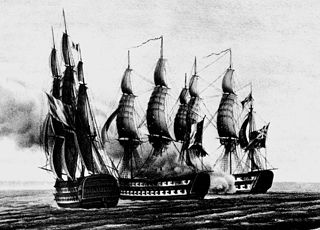
HMS Agincourt was a 64-gun third-rate ship of the line of the Royal Navy, launched on 23 July 1796 at Blackwall Yard, London. The Admiralty bought her on the stocks from the East India Company in 1796, who had called her Earl Talbot.

HMS Ajax was an Ajax-class 74-gun third-rate ship of the line of the British Royal Navy. She was built by John Randall & Co of Rotherhithe and launched on the Thames on 3 March 1798. Ajax participated in the Egyptian operation of 1801, the Battle of Cape Finisterre in 1805 and the Battle of Trafalgar, before she was lost to a disastrous fire in 1807 during the Dardanelles Operation.

HMS Minotaur was a 74-gun third-rate ship of the line of the Royal Navy launched on 6 November 1793 at Woolwich. She was named after the mythological bull-headed monster of Crete. She fought in three major battles – Nile, Trafalgar, and Copenhagen (1807) – before she was wrecked, with heavy loss of life, in December 1810.
HMS Renown was a 74-gun third-rate ship of the line of the Royal Navy. She was to have been named HMS Royal Oak, but the name was changed to Renown on 15 February 1796. She was launched at Deptford Wharf on 2 May 1798 and served in 1800-1801 as the flagship of Sir John Borlase Warren, initially in the English Channel.

HMS Swiftsure was a 74-gun third rate ship of the line of the British Royal Navy. She spent most of her career serving with the British, except for a brief period when she was captured by the French during the Napoleonic Wars in the action of 24 June 1801. She fought in several of the most famous engagements of the French Revolutionary and Napoleonic Wars, fighting for the British at the Battle of the Nile, and the French at the Battle of Trafalgar.

HMS Thetis was a 38-gun fifth-rate frigate of the Royal Navy launched in 1782.

Tigre was a 74-gun ship of the line of the French Navy. Later it was captured by the British and, as HMS Tigre, operated as part of the Royal Navy throughout the Napoleonic Wars.
There have been five ships of the Royal Navy to bear the name HMS Urchin after the Sea urchin:

HMS Northumberland was a 74-gun third-rate ship of the line of the Royal Navy, built at the yards of Barnard, Deptford and launched on 2 February 1798. She carried Napoleon to his final exile on St Helena.
HMS Stately was a 64-gun third-rate ship of the line of the Royal Navy, launched on 27 December 1784 at Northam.

HMS Diadem was a 64-gun third rate ship of the line of the Royal Navy, launched on 19 December 1782 at Chatham. She participated in the Battle of Cape St Vincent in 1797 under Captain George Henry Towry.
HMS Inflexible was a 64-gun third rate ship of the line of the Royal Navy, launched on 7 March 1780 at Harwich.
HMS Dictator was a 64-gun third-rate ship of the line of the Royal Navy, launched on 6 January 1783 at Limehouse. She was converted into a troopship in 1798, and broken up in 1817.
HMS Kent was a 74-gun third-rate ship of the line of the Royal Navy, launched on 17 January 1798 at Blackwall Yard.

HMS Dragon was a 74-gun third rate ship of the line of the Royal Navy, launched on 2 April 1798 at Rotherhithe. She was designed by Sir William Rule, and was the only ship built to her draught.

HMS Monmouth was a 64-gun third rate ship of the line of the Royal Navy, launched on 23 April 1796 at Rotherhithe. She had been designed and laid down for the East India Company, but the Navy purchased her after the start of the French Revolutionary War. She served at the Battle of Camperdown and during the Napoleonic Wars. Hulked in 1815, she was broken up in 1834.

HMS Pembroke was a 74-gun third rate ship of the line of the Royal Navy, launched on 27 June 1812 at Blackwall Yard.
HMS Chichester was a 70-gun third rate ship of the line of the Royal Navy, designed by Sir Joseph Allin and built by Peirson Lock at Portsmouth Dockyard to the standard draught for 70-gun ships as specified in the 1745 Establishment amended in 1750, and launched on 4 June 1753.

HMS Winchelsea was a 32-gun fifth-rate Niger-class frigate of the Royal Navy, and was the sixth Royal Navy ship to bear this name. She was ordered during the Seven Years' War, but completed too late for that conflict. She cost £11,515-18-0d to build.

Cruelle was a schooner-cannoniere (gun-schooner), launched in 1793. The British captured her in June 1800 and commissioned her as HMS Cruelle. She spent a little over a year in the Mediterranean, serving at Malta and Alexandria before the Royal Navy sold her in 1801.














